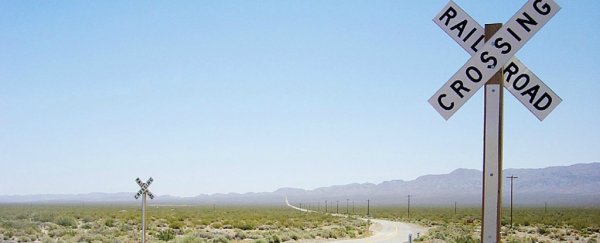Picture this: you're driving in your car, and come to a railway crossing with a train approaching in the distance. It's coming towards you, but you're sure it's still ages away and travelling pretty slowly.
Based on that, it'd be easy to assume you could make it over the tracks with plenty of time to spare, but new research suggests your perception is nowhere near as accurate as you think, and you might be putting yourself, and anyone else in the car, in danger.
A collaboration between the Queensland University of Technology (QUT) in Australia and the Australasian Centre for Rail Innovation has been investigating when drivers can see a train in the distance, and if they can gauge how fast it's going.
The aim is to try and figure out if drivers are able to make reliable judgements regarding if and when they can cross train tracks at level crossings - which are notoriously dangerous for drivers.
"Railway crossings are designed to an Australian standard that calculates the sighting distance required to safely navigate a level crossing based on the physics of moving vehicles," Gregoire Larue, a researcher with QUT's Centre for Accident Research & Road Safety, explains.
But even so, 35 Australians are still killed every year at level crossings.
The study tested 36 drivers in Victoria to assess the distances they could clearly see an oncoming train from, and how accurate they were in deciding how fast the train was going.
"What we found was that most drivers could see the train from a very long distance, with 85 percent identifying a train further than 1,450 m," he said. "Drivers were also able to identify the train as moving on average at a distance of 1,298 m away."
But it turns out that humans are pretty error prone when it comes to high-speed vehicles. When the participants saw a train was coming towards them, they got the speed of the train wrong by up to 55 km/h.
"At 1,100 m away drivers' speed estimate was on average 44 percent lower than the actual train speed, so despite travelling at 130 km/h drivers thought the train was travelling at 75 km/h," Larue said.
"At 750 m away drivers' speed estimate was on average 36 percent lower than the actual train speed, so despite travelling 130 km/h drivers thought the train was travelling at 85 km/h."
Those numbers make a pretty big difference when it comes to assessing whether or not you have enough time to safely clear a crossing.
Even when the train was only 350 metres away, travelling at 130 km/h, drivers estimated it was going on average 40 km/h slower than it actually was.
This means that more than 15 extra seconds could be required to safely clear the crossing - something that's now been addressed in the Australasian Centre for Rail Innovation standard, so a risk assessment could be done to any level crossings that require long sighting distances.
"At the upper end of the sighting distances proposed (750 to 1500 m), industry has raised concern around whether a driver would be able to reliably identify a train and assess its rate of approach in order to make an informed decision regarding whether it would be safe to proceed across the level crossing," said Larue.
"The standard now also includes reference to the human limitations in detecting the movement of the train, particularly beyond 750 metres."
The findings were presented at the Conference on Railway Excellence in Melbourne in April, and published in a report by the Australasian Centre for Rail Innovation.
Queensland University of Technology is a sponsor of ScienceAlert. Find out more about their research.
